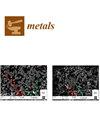Features of Increasing the Wear Resistance of 90CrSi Tool Steel Surface under Various Electrophysical Parameters of Plasma Electrolytic Treatment
IF 2.5
3区 材料科学
Q3 MATERIALS SCIENCE, MULTIDISCIPLINARY
引用次数: 0
Abstract
The paper investigates the feasibility of plasma electrolytic treatment (PET) of 90CrSi tool steel to enhance hardness and wear resistance. The influence of electrophysical parameters of PET (polarity of the active electrode, chemical-thermal treatment, and polishing modes) on the composition, structure, morphology, and tribological properties of the surface was studied. Tribological tests were carried out under dry friction conditions according to the shaft-bushing scheme with fixation of the friction coefficient and temperature in the friction contact zone, measurements of surface microgeometry parameters, morphological analysis of friction tracks, and weight wear. The formation of a surface hardened to 1110–1120 HV due to the formation of quenched martensite is shown. Features of nitrogen diffusion during anodic PET and cathodic PET were revealed, and diffusion coefficients were calculated. The wear resistance of the surface of 90CrSi steel increased by 5–9 times after anodic PET followed by polishing, by 16 times after cathodic PET, and up to 32 times after subsequent polishing. It is shown that in all cases, the violation of frictional bonds occurs through the plastic displacement of the material, and the wear mechanism is fatigue wear during dry friction and plastic contact.等离子电解处理的各种电物理参数下提高 90CrSi 工具钢表面耐磨性的特点
本文研究了对 90CrSi 工具钢进行等离子电解处理(PET)以提高硬度和耐磨性的可行性。研究了 PET 的电物理参数(活性电极极性、化学热处理和抛光模式)对表面成分、结构、形态和摩擦学特性的影响。根据轴-衬套方案,在干摩擦条件下进行了摩擦学试验,固定了摩擦接触区的摩擦系数和温度,测量了表面微观几何参数、摩擦轨迹形态分析和重量磨损。结果表明,由于淬火马氏体的形成,表面硬化至 1110-1120 HV。揭示了阳极 PET 和阴极 PET 期间氮扩散的特征,并计算了扩散系数。90CrSi 钢表面的耐磨性在阳极 PET 后抛光后提高了 5-9 倍,在阴极 PET 后提高了 16 倍,在后续抛光后提高了 32 倍。结果表明,在所有情况下,摩擦结合的破坏都是通过材料的塑性位移发生的,磨损机理是干摩擦和塑性接触过程中的疲劳磨损。
本文章由计算机程序翻译,如有差异,请以英文原文为准。
求助全文
约1分钟内获得全文
求助全文
来源期刊

Metals
MATERIALS SCIENCE, MULTIDISCIPLINARY-METALLURGY & METALLURGICAL ENGINEERING
CiteScore
4.90
自引率
13.80%
发文量
1832
审稿时长
1.5 months
期刊介绍:
Metals (ISSN 2075-4701) is an open access journal of related scientific research and technology development. It publishes reviews, regular research papers (articles) and short communications. Our aim is to encourage scientists to publish their experimental and theoretical results in as much detail as possible. Therefore, there is no restriction on the length of the papers. The full experimental details must be provided so that the results can be reproduced. Metals provides a forum for publishing papers which advance the in-depth understanding of the relationship between the structure, the properties or the functions of all kinds of metals.
 求助内容:
求助内容: 应助结果提醒方式:
应助结果提醒方式:


